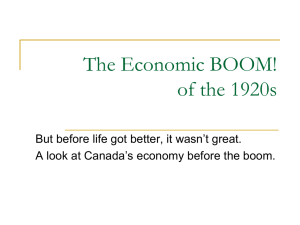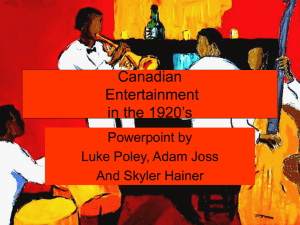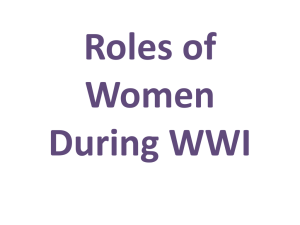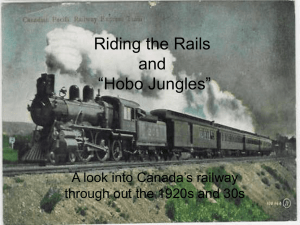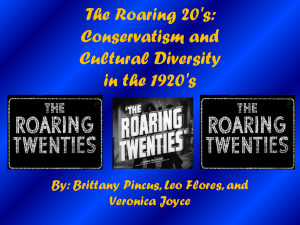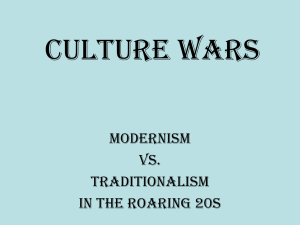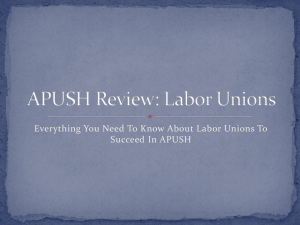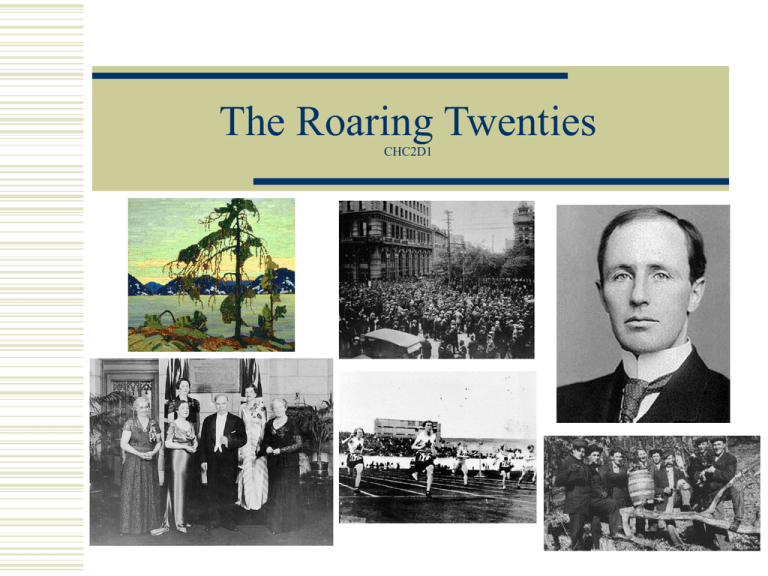
The Roaring Twenties
CHC2D1
Introduction
After WW1 there was a period of adjustment:
The economy was moving away from war production
The unemployment rate was high across Canada at the beginning of the 20’s
People were dissatisfied with politicians
Canada was moving closer economically and culturally with the United States
The Aboriginal People faced the possibility of loosing their language and cultures
Canadian nationalism was growing and Canadians were creating a distinct Canadian
identity
Attitudes towards women were changing
Women’s style reflected some new freedoms
Technology and new inventions changed the world
As the economy improved, people started to spend money on appliances, telephones,
radios and sporting events
Many people were optimistic about the future and thought that the good times were only
going to get better.
The Canadian Economy
The Winnipeg General Strike - May 1919
Pg. 67-69
Economy adjusting to peacetime
Industries that had munitions were now in the process of retooling their factories
Unemployment increased
Many veterans returned returned to find their jobs were either gone or taken by those who
remained home
Dramatic rise in the cost of living
Soldiers felt that they sacrificed enough during the war that they deserved to be
compensated with jobs and higher wages
This frustration was directed towards the federal government
On May 15, 1919 a General Strike occurred in Winnipeg
24,000 workers went on strike
By May 17th, there were 35,000 strikers
The strike affected telephone operations, hotels, restaurants, newspapers and food supplies
The employers reacted to the strike by creating a Citizens Committee and organizing a militia
force of 5000 men
The Canadian Economy
The Winnipeg General Strike - May 1919 Con’t
Pg. 67-69
The strike soon became more than an economic movement, took on an
anti-foreigner focus
As the speeches of the union leaders became more and more radical, the
federal government in the militia to retain order
The federal government also passed the Immigration Act that allowed
them to deport any citizen not born in Canada
On June 17th, a number of union leaders were arrested
On June 21st, a crowd gathered together to protest the lack of progress in
negotiations and arrest of the strike leaders. It became violent and the
protesters attacked a streetcar, set it on fire and threw rocks at the troops
The Riot Act was read and the police charged the crowd with their
weapons drawn.
The Strike was broken and the Federal Minister of Justice (Arthur
Meighen) passes a law that gave the government permission to arrest
and deport anyone considered a threat
The strike demonstrated what could happen with workers feeling
exploited.
The Canadian Economy
pg. 73
Although some unemployment, Ont, Que, and B.C. experienced good economic
times throughout most of the 1920’s
Strong demand for pulp, paper, cars and other goods not available during the war
By 1923 the Roaring 20’s had begun and people saw more consumer products
than they had ever seen before
BUT…
The Prairies and the Maritimes were experiencing hard times as wheat prices
were falling (they no longer needed to feed the oversea troops)
Some people in the Prairie and Maritime provinces felt that the Ottawa
politicians did not care about them and started taking about creating new
political parties or even separating from Canada.
Farmers in the Prairies and Ontario created the Progressive Party
Byng-King Crisis
Pg. 75-76
A scandal erupted that shook the Liberal Party – it was discovered that some of
the Liberals had been taking brides to allow the smuggling alcohol into the U.S.
The newly elected Progessive MP’s would not support a corrupt gov’t
P.M. King knew his government was in trouble
Only time before Arthur Meighen (leader of the conservatives) called a nonconfidence vote
Before the vote could be taken King asked Lord Byng (Canada’s Governor
General) to call a new election
Byng refused the request and asked Meighen to become the Prime Minister
Meighen’s rein as P.M. only lasted 3 days and a new election was held
King used Canada’s nationalism in his speeches to ask how an unelected official
can tell the Prime Minister what to do.
King returned to office in 1926
Conditions of Canada’s
Aboriginal Peoples
Pg. 76-77
Aboriginal peoples did not benefit from the prosperity of the 1920’s
The Canadian gov’t continued to make decisions for them
Government parties continued to encourage assimilation
The quality of life on the reserved continued to decline
Alcohol was consumed in unhealthy amounts
Suicide rates were the highest in the country
Diseases like tuberculosis continued to kill many
Inferior housing
Policymakers saw residential schools as the ideal way to ‘assimilate’ Native Canadian
children
Completely remove children from their communities and forced into ‘moral’ education that promoted the
values of ‘White Society’
Little or no contact with families (officials were concerned children would revert)
Prohibited children from speaking their Native languages, forced to wear
uniforms and severely punished if rules were broken
But some began to fight against the injustices done to their people
F.O. Loft (Mohawk Chief) set up the League of Indians of Canada
Other leaders were organizing their people to fight back and obtain justice
Canadian Art and Culture
Pg. 79-82
Art
Group of Seven
J.E.H. MacDonald, Lawren Harris, Franklin Carmichael, Arthur
Lismer, F.H. Varley, A.Y. Jackson and Franz Johnson
The artwork expressed Canada’s physical richness and beauty
Literature
A new style of Canadian literature would encourage and
influence later generations of Canadian writers
Sports
“Canada’s Golden Age of Sports”
Canadian athletes won medals and trophies all around the world
Bluenose in 1921
Professional hockey emerged as one of Canada’s favorite sports
1928 Olympics (Bobbie Rosenfeld, Percy Williams)
Canadian Women in the 1920’s
Pg. 84-87
Alberta’s Famous Five
In 1927 a group of western women asked Parliament if women were considered ‘persons’
They were called the “Famous Five”: Emily Murphy, Irene Parlby, Nellie McClung, Henrietta
Edwards, Louise McKinney
Before them the word ‘person’ in the Canadian Constitution meant only those of the male sex
The Persons Case went to the Supreme Court of Canada and in 1928 the Court ruled that the
word ‘persons’ in the Constitution meant only male persons
The women kept fighting and appealed the decisions to the British Privy Council and in 1929
(to the surprise of many) the Council overturned the Supreme Court of Canada’s decision
Canadian Women in the 1920’s
Pg. 84-87
Fashion
Clothing styles for women were changing
Hemlines rose above the knee
“Boyish” look was in
Indicated that women were freer to to more than
before and were more equal to men
Called ‘flappers”
However many men and women considered this
lifestyle too extreme.
Prohibition
Pg. 87-89
Between 1915-1917 Canadian Temperance Movements were able to outlaw the
sale and consumption of alcohol in every province except Quebec
This was called Prohibition
In the U.S. prohibition was federal law from 1920-1933. In Canada, however, it
sputtered out. Most provinces gave up on total prohibition by the mid-1920’s
Prohibition did reduce alcohol consumption by 80%. However, it also inspired a
wave of crime that created tensions between the U.S. and Canada
Many people were prepared to break the laws; they liked to drink or wanted to
get rich selling alcohol illegally.
The United States was the major market for the illegal alcohol
‘Rum-running’ became big-business
‘Bootleggers’ sprung up everywhere
Liquor was transported to the United States by boats, trucks, cars and trains
Oakville – Chisolm family – founder of Oakville – his house was used to
smuggle alcohol down to harbour in the 1930’s
Oakville made a lot of money from the selling of illegal liquor
Prohibition
Pg. 87-89
Changes in Technology
Pg. 89-92
Insulin
Frederick Banting in 1921
1922 Leonard Thompson, a 14 year old boy, was the first person
treated
The Telephone
In 1920 1 in 4 families had a phone
In 1929 3 of 4 families had a phone
The Automobile
The Model T car was mass produced and flooded the market
Millions of jobs were created
The Airplane
Air transport expanded rapidly between 1920 and 1937
The Radio
First radio broadcast in North America was on May 20, 1920
New type of entertainment
CBC – The Canadian Broadcasting Corporation was created
Hockey Night in Canada first aired on March 22, 1923


